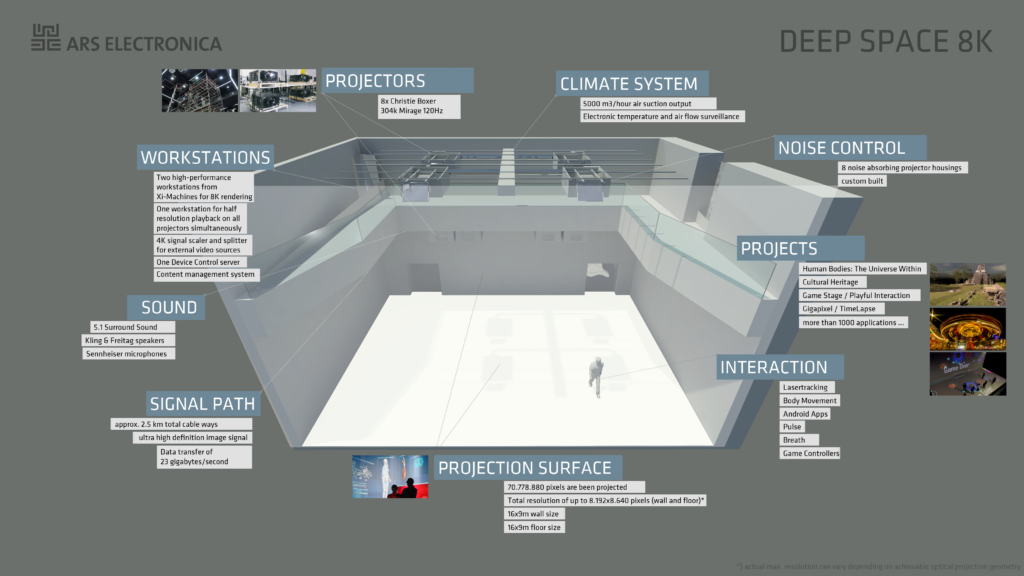Interactive Authoring, Deep Space DevKit
Authors: Clemens Scharfen; Roland Haring; Ali Nikrang
Version 1.4.1 – 28.12.2019
Abstract
The Ars Electronica Deep Space 8K Unity Development Kit shall make it possible for developers all over the world to easily create Unity applications for the Deep Space 8K, a large-scale multiuser VR environment. This guideline gives an overview of the Deep Space 8K possibilities and explains the SDK in detail.
The Deep Space 8K is a large-scale multiuser VR environment developed by Ars Electronica. Its projection surface of about 16 x 9 meters both at the wall and the floor, its eight 4K projectors, a surround-sound audio system and a laser tracking system allow for a unique immersive audio-visual experience in 8K resolution: From Gigapixel photography, time-lapse videos, historic sites in 3D, images from within the human body and hands-on games – the possibilities in Deep Space 8K are manifold. The Deep Space 8K has not only been transformed into smaller, even mobile versions such as for the Science Centre Singapore in 2015 but it has recently also been replicated in its entirety at the Centro de Ciencias in Culiacan in Sinaloa, Mexico, where it is called Cubo Negro.
Besides Immersify, the Deep Space Software Development Kit presented in the following file has been successfully used for the following applications and projects, among others:
- The Great Pyramid (Ars Electronica)
- The Old Synagogue in Linz – A Virtual Tour (Ars Electronica)
- Future Urban Mobility TUMCREATE (Ars Electronica)
- Merck 350 Curiosity Space (Ars Electronic, Merck KGaA, Hagenberg Campus of the University of Applied Sciences Upper Austria, Gerhard Funk)
- PAC-MAN FUNGUAGE (BANDAI NAMCO Research Inc., Hakuhodo and Ars Electronica)
- City Lights (Hagenberg Campus of the University of Applied Sciences Upper Austria)
- Mirage (St. Pölten University of Applied Sciences) [TBP]
To allow for a broad range of creative individuals working with high-quality videos, CGI in 2D and 3D, as well as interactive elements to have the option of combining them with each other so that users are in a position to enjoy totally customized experiences as seen in the example of Deep Space 8K, we are making a Software Development kit for the implementation of such an VR environment available with this guideline.
This guideline is designed for content developers and engineers in the fields of virtual environments and immersive spaces as well as members of other professions interested in this subject. It provides information on the technological possibilities of the Deep Space 8K, its components and how to easily create Unity applications for it. At the end of the guideline you will find a troubleshooting section, a Q&A segment as well as information on licencing and support options.
Overview
The Deep Space 8K installation consists of multiple components, all of which are a vital part to creating immersive experiences:

This guideline contains detailed information on the supported hardware necessary for the Deep Space installation. Essentially, the Software Development Kit makes it easier to develop applications in the Deep Space, including the use of functionalities such as Stereo Rendering (3D with glasses), Pharus Tracking (position detection of people inside the Deep Space), VRPN (control via mobile phone), the ‘fusion’ of wall and floor and other features described in the file:
- The Pharus Laser Tracking System: This application tracks the position of people standing in the projection area.
- An XBox Controller: Prepared to be easily used in the Deep Space.
- A Mobile Control option: A special application that can be filled dynamically with content that helps to control the content.
- VRPN: A well-known protocol which can simulate button pushes or send the Deep Space mobile phone acceleration data.
The Deep Space Development Kit supports all available interfaces in the Deep Space individually as well as a fast application development for this VR room.
The following elements will allow for a faster development for the Deep Space:
- Wall-Floor-Offaxis-Camera: A premade setup to combine the views for the wall and floor projection for an unforgettable immersive experience.
- Command Line Config Manager: Enables the configuration of an application easily without having much programming effort.
- Networking: Synchronization of objects between wall and floor (e.g. the camera position) is already prepared and can easily be extended to fulfil other needs.
The development kit also provides a project as a starting point to make the set-up quick and simple. However, if you do not want to use this project and would rather integrate the Deep Space Dev Kit functionality into your own project, the workflow is explained as well.
A quick impression on the controls, views and interfaces of the application can be seen in this talk by Roland Haring, Michael Mayr und Clemens Scharfen from the Ars Electronica Futurelab at Unite 2015 in Boston.
For an insider glimpse on the technology used at the Deep Space and to get an idea of how its components can be set up you can also watch this short behind-the-scenes clip from Ars Electronica.
